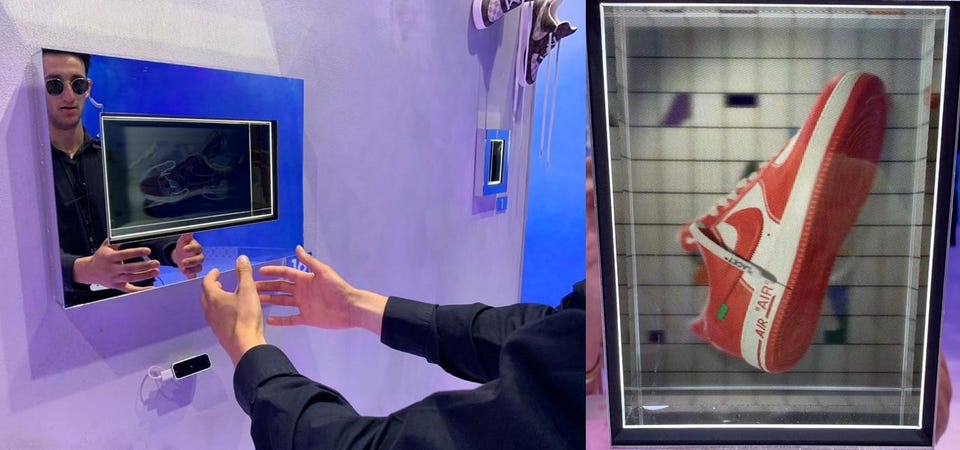CMO Network Will Holograms Be The Next Big Media Format? They’re Not The Holograms You Remember! Michelle Greenwald Contributor Opinions expressed by Forbes Contributors are their own. Cross-pollinator, world explorer, author, consultant, professor New! Follow this author to improve your content experience. Got it! Jun 29, 2022, 02:26am EDT | Share to Facebook Share to Twitter Share to Linkedin Looking Glass Factory sneaker hologram that expands and rotates with gesture recognition, at the .
. . [+] LOUIS VUITTON X NIKE ‘AIR FORCE 1’ BY VIRGIL ABLOH EXHIBITION In Greenpoint, Brooklyn, May 31, 2022 Michelle Greenwald When Shawn Frayne was just a 10 year old in Orlando, Florida, his dad took him to see Back to the Future 2 , which set the trajectory for his life-long passion to advance hologram technology.
He was entranced by the holographic shark in the movie and dreamt of one day making holograms much more refined, engaging, and realistic. When Shawn was 14, his dad helped him create a hologram animation studio in his bedroom and he made his first animated hologram. From then on, Shawn kept experimenting and perfecting his techniques.
He enrolled in MIT which offered the most cutting-edge undergraduate studies related to holograms, as MIT’s then dean was a strong believer in the field’s future. Fast forward to early June 2022 when Shawn’s hardware & software company, Looking Glass Factory, launched the largest holographic display in the world – the Looking Glass 65”, 4X larger than any other group viewable 3D holographic display. I was one of the first to see it and was amazed by how such a flat screen could convey so much depth and 3D perspective.
All of the company’s systems allow large groups of people to view up to 100 different perspectives of 3D, lifelike content at the same time. The holograms feel like they are floating out of the screen with realism and depth, and it’s experienced without a headset, eye-tracking, or 3D glasses. The secret of Looking Glass Factory’s technology lies in the proprietary hardware and software-generated optics that convey subtle shadows and light, not dissimilar to what the French painter Monet did when painting the cathedral of Rouen under so many different light conditions, and Leonardo da Vinci tried captured in his paintings.
Shawn quoted the latter who said “the crowning achievement of painting arises from light and shade. The essence of good painting, and the key to making an object look three-dimensional, is getting the shadows right”, and that’s why Leonardo spent more time studying and writing about shadows than he did any other artistic topic. Targets users of the Looking Glass hardware and software include individuals and enterprises.
The 65” model is great for experiential marketing, 3D storytelling, engineering, design, medical and scientific visualization, R&D, and creating art, photography, and film. Springbok Entertainment just launched film Zanzibar:Trouble in Paradise , the first ever holographic movie or documentary, in competition at the Tribeca Film Festival in June. According to Brandon Zamel, CEO of Springbok Entertainment, “the massive increase in the holographic size gives 3D storytellers the ideal canvas to push the boundaries of immersive experiences.
It’s the beginning of a new way of experiencing movies. ” But the technology is not just for movies. Users can use nearly any 3D content including the new capture capabilities in phones like iPhone X, 11, and 12 to create holograms using Looking Glass Factory’s software and creator tools.
These holograms can then be displayed on any size Looking Glass; including the 7. 9” desktop Portrait model. Looking Glass’s media player, HoloPlay Studio, easily views, edits, and syncs holographic media and direct integrations are available for Unity, Unreal and Blender 3D software and creation tools.
MORE FOR YOU In Crypto ‘Arms Race’ For Mass Adoption, Companies Ink Sports Sponsorships Worth Hundreds Of Millions CAA Signs Jenkins The Valet: Is This A Sign That Hollywood Is Embracing NFTs? HPE’s Sandy Ono On Insights At Hyper Speed To Drive Growth And The Value Of Marketing’s Currency There are numerous examples that evidence that the Looking Glass’s holograms are ready for prime time. I recently visited the Louis Vuitton and Nike’s “Dream Now” exhibition in Greenpoint, Brooklyn which used around 50 different holograms to display 3D sneakers. Through touch-free gesture recognition technology, visitors could expand and rotate the 3D collector shoe images.
The displays were also used in numerous experiential marketing activations with key brands at the Cannes Lions Festival. Other examples of brand marketing applications that we can expect to see more of include out-of-home advertising, retail installations, trade shows and events, theme parks, and digital art galleries. Another indication is the diversity of heavy hitter, tech savvy board members like Sabrina Kieffer, former SVP at Vimeo and COO of Skillshare, and Brenda Freeman, formerly at Turner Broadcasting, DreamWorks, National Geographic, Magic Leap and Arteza.
As always, I like uncovering new media formats that reduce customer friction and provide great immersive experiences. Since it’s just the beginning for the broad adoption of holograms, it’s up to brands and their agencies to start exploring the opportunities which are limited only by our imaginations. Follow me on Twitter or LinkedIn .
Check out my website or some of my other work here . Michelle Greenwald Editorial Standards Print Reprints & Permissions.
From: forbes
URL: https://www.forbes.com/sites/michellegreenwald/2022/06/29/will-holograms-be-the-next-big-media-format-theyre-not-the-holograms-you-remember/
